Preparation and Modification of Polydopamine Boron Nitride—Titanium Dioxide Nanohybrid Particles Incorporated into Zinc Phosphating Bath to Enhance Corrosion Performance of Zinc Phosphate-Silane Coated Q235 Steel
Abstract
:1. Introduction
2. Materials and Methods
2.1. Materials
2.2. Preparation of PDA@BN/TiO2 (PBT) Nanohybrids
2.3. Pre-Preparation of Mild Steel Sheets
2.4. Phosphating Procedure
2.5. Characterization of PDA@BN/TiO2
2.6. EIS Measurements
3. Results
3.1. Characterization of PDA@BN/TIO2 (PBT)
3.1.1. SEM Analysis
3.1.2. XRD Patterns
3.1.3. FT-IR Spectroscopy
3.1.4. Digital Photos Dispersibility
3.2. FESEM of PDA@BN/TiO2 Incorporated Phosphate-Silane-Coated Samples
3.3. EDS mapping of PDA@BN-TiO2
3.4. Coating Mass of PDA@BN-TiO2 Phosphate Coating
3.5. XRD Patterns of PDA@BN-TiO2
3.6. XPS Analysis of PDA@BN-TiO2 Phosphate-Silane Coatings
3.7. SEM Characterization
3.8. Phosphating Mechanism
3.9. Corrosion Behavior
3.9.1. Potentiodynamic Polarization Characterization
3.9.2. Electrochemical Impedance Spectroscopy (EIS)
3.10. Copper Sulphate Spot Testing
4. Conclusions
Author Contributions
Funding
Institutional Review Board Statement
Informed Consent Statement
Data Availability Statement
Conflicts of Interest
References
- Muhammad, M.; Hu, S.; Ma, R.; Du, A.; Wang, M.; Fan, Y.; Zhao, X.; Yang, H.; Li, C.; Cao, X. Enhancing the corrosion resistance of Q235 mild steel by incorporating poly(dopamine) modified h-BN nanosheets on zinc phosphate-silane coating. Surf. Coat. Technol. 2020, 390, 125682. [Google Scholar] [CrossRef]
- Pokorny, P.; Tej, P.; Szelag, P. Chromate conversion coatings and their current application. Metalurgija 2016, 55, 253–256. [Google Scholar]
- Walker, D.; Wilcox, G. Molybdate based conversion coatings for zinc and zinc alloy surfaces: A review. Trans. IMF 2008, 86, 251–259. [Google Scholar] [CrossRef]
- Pommiers, S.; Frayret, J.; Castetbon, A.; Potin-Gautier, M. Alternative conversion coatings to chromate for the protection of magnesium alloys. Corros. Sci. 2014, 84, 135–146. [Google Scholar] [CrossRef]
- Hu, S.; Muhammad, M.; Wang, M.; Ma, R.; Du, A.; Fan, Y.; Cao, X.; Zhao, X. Corrosion resistance performance of nano-MoS2-containing zinc phosphate coating on Q235 steel. Mater. Lett. 2020, 265, 127256. [Google Scholar] [CrossRef]
- Di Giampaolo, A.; Medina, M.; Reyes, R.; Velez, M. Zinc phosphate interlayer for sol-gel-derived aluminosilicate coating on AISI-1010 carbon steel. Surf. Coat. Technol. 1997, 89, 31–37. [Google Scholar] [CrossRef]
- Huang, H.; Wang, H.; Xie, Y.; Dong, D.; Jiang, X.; Zhang, X. Incorporation of boron nitride nanosheets in zinc phosphate coatings on mild steel to enhance corrosion resistance. Surf. Coat. Technol. 2019, 374, 935–943. [Google Scholar] [CrossRef]
- Xie, Y.; Chen, M.; Xie, D.; Zhong, L.; Zhang, X. A fast, low temperature zinc phosphate coating on steel accelerated by graphene oxide. Corros. Sci. 2017, 128, 1–8. [Google Scholar] [CrossRef]
- Shen, H.; Guo, J.; Wang, H.; Zhao, N.; Xu, J. Bioinspired Modification of h-BN for High Thermal Conductive Composite Films with Aligned Structure. ACS Appl. Mater. Interfaces 2015, 7, 5701–5708. [Google Scholar] [CrossRef]
- Gao, Z.; Zhang, D.; Li, X.; Jiang, S.; Zhang, Q. Current status, opportunities and challenges in chemical conversion coatings for zinc. Colloids Surf. A Physicochem. Eng. Asp. 2018, 546, 221–236. [Google Scholar] [CrossRef]
- Arthanareeswari, M.; Kamaraj, P.; Tamilselvi, M.; Devikala, S. A low temperature nano TiO 2 incorporated nano zinc phosphate coating on mild steel with enhanced corrosion resistance. Mater. Today Proc. 2018, 5, 9012–9025. [Google Scholar] [CrossRef]
- Cui, M.; Ren, S.; Chen, J.; Liu, S.; Zhang, G.; Zhao, H.; Wang, L.; Xue, Q. Anticorrosive performance of waterborne epoxy coatings containing water-dispersible hexagonal boron nitride (h-BN) nanosheets. Appl. Surf. Sci. 2017, 397, 77–86. [Google Scholar] [CrossRef]
- Huang, Y.-C.; Lo, T.-Y.; Chao, C.-G.; Whang, W.-T. Anti-corrosion characteristics of polyimide/h-boron nitride composite films with different polymer configurations. Surf. Coat. Technol. 2014, 260, 113–117. [Google Scholar] [CrossRef]
- Dennis, R.; Patil, V.; Andrews, J.; Aldinger, J.; Yadav, G.; Banerjee, S. Hybrid nanostructured coatings for corrosion protection of base metals: A sustainability perspective. Mater. Res. Express. 2015, 2, 032001. [Google Scholar] [CrossRef]
- Qiao, J.; Jin, X.; Qin, J.; Liu, H.; Luo, Y.; Zhang, D. A super-hard superhydrophobic Fe-based amorphous alloy coating. Surf. Coat. Technol. 2018, 334, 286–291. [Google Scholar] [CrossRef]
- Uchida, S.; Chiba, R.; Tomiha, M.; Masaki, N.; Shirai, M. Application of Titania Nanotubes to a Dye-sensitized Solar Cell. Electrochemistry 2002, 70, 418–420. [Google Scholar] [CrossRef]
- Shibli, S.; Chacko, F. Development of nano TiO2-incorporated phosphate coatings on hot dip zinc surface for good paintability and corrosion resistance. Appl. Surf. Sci. 2011, 257, 3111–3117. [Google Scholar] [CrossRef]
- Li, L.-Y.; Cui, L.-Y.; Liu, B.; Zeng, R.-C.; Chen, X.-B.; Li, S.-Q.; Wang, Z.-L.; Han, E.-H. Corrosion resistance of glucose-induced hydrothermal calcium phosphate coating on pure magnesium. Appl. Surf. Sci. 2019, 465, 1066–1077. [Google Scholar] [CrossRef]
- Wang, T.; Ge, H.; Zhang, K. A novel core-shell silica@graphene straticulate structured antistatic anticorrosion composite coating. J. Alloys Compd. 2018, 745, 705–715. [Google Scholar] [CrossRef]
- Wang, S.; Zhu, J.; Rao, Y.; Li, B.; Zhao, S.; Bai, H.; Cui, J. Polydopamine Modified Graphene Oxide-TiO2 Nanofiller for Reinforcing Physical Properties and Anticorrosion Performance of Waterborne Epoxy Coatings. Appl. Sci. 2019, 9, 3760. [Google Scholar] [CrossRef]
- Yue, Y.-Y.; Liu, Z.-X.; Wan, T.-T.; Wang, P.-C. Effect of phosphate–silane pretreatment on the corrosion resistance and adhesive-bonded performance of the AZ31 magnesium alloys. Prog. Org. Coat. 2013, 76, 835–843. [Google Scholar] [CrossRef]
- Banczek, E.; Terada, M.; Rodrigues, P.; Costa, I. Effects of Niobium Ammonium Oxalate and Benzotriazole on the Corrosion Resistance of Zinc Phosphate Layer. J. Mater. Eng. Perform. 2013, 22, 3572–3583. [Google Scholar] [CrossRef]
- Sinha, P.; Feser, R. Phosphate coating on steel surfaces by an electrochemical method. Surf. Coat. Technol. 2002, 161, 158–168. [Google Scholar] [CrossRef]
- Huang, H.; Huang, X.; Xie, Y.; Tian, Y.; Jiang, X.; Zhang, X. Fabrication of h-BN-rGO@PDA nanohybrids for composite coatings with enhanced anticorrosion performance. Prog. Org. Coat. 2019, 130, 124–131. [Google Scholar] [CrossRef]
- Shen, L.; Zhao, Y.; Wang, Y.; Song, R.; Yao, Q.; Chen, S.; Chai, Y. A long-term corrosion barrier with an insulating boron nitride monolayer. J. Mater. Chem. A 2016, 4, 5044–5050. [Google Scholar] [CrossRef]
- Ma, W.-F.; Zhang, Y.; Li, L.-L.; You, L.-J.; Zhang, P.; Zhang, Y.-T.; Li, J.-M.; Yu, M.; Guo, J.; Lu, H.-J.; et al. Tailor-Made Magnetic Fe3O4@mTiO2 Microspheres with a Tunable Mesoporous Anatase Shell for Highly Selective and Effective Enrichment of Phosphopeptides. ACS Nano 2012, 6, 3179–3188. [Google Scholar] [CrossRef]
- Wang, X.; Hu, W.; Hu, Y. Polydopamine-Bridged Synthesis of Ternary h-BN@PDA@TiO2 as Nanoenhancers for Thermal Conductivity and Flame Retardant of Polyvinyl Alcohol. Front. Chem. 2020, 8, 587474. [Google Scholar] [CrossRef]
- Shao, L.; Quan, S.; Liu, Y.; Guo, Z.; Wang, Z. A novel “gel–sol” strategy to synthesize TiO2 nanorod combining reduced graphene oxide composites. Mater. Lett. 2013, 107, 307–310. [Google Scholar] [CrossRef]
- Li, G.; Xing, R.; Geng, P.; Liu, Z.; He, L.; Wang, N.; Zhang, Q.; Qu, X. Surface modification of boron nitride via poly (dopamine) coating and preparation of acrylonitrile-butadiene-styrene copolymer/boron nitride composites with enhanced thermal conductivity. Polym. Adv. Technol. 2018, 29, 337–346. [Google Scholar] [CrossRef]
- Ge, X.; Liang, W.; Ge, J.; Chen, X.; Ji, J.; Pang, X.; He, M.; Feng, X. Hexagonal boron nitride/microfibril cellulose/ poly(vinyl alcohol) ternary composite film with thermal conductivity and flexibility. Materials 2018, 12, 104. [Google Scholar] [CrossRef]
- Sheng, Y.; Yang, J.; Wang, F.; Liu, L.; Liu, H.; Yan, C.; Guo, Z. Sol-gel synthesized hexagonal boron nitride/titania nanocomposites with enhanced photocatalytic activity. Appl. Surf. Sci. 2019, 465, 154–163. [Google Scholar] [CrossRef]
- Jung, H.; Nam, K.; Sung, H.-G.; Hyun, H.; Sohn, Y.; Shin, W. Preparation of TiO2-Decorated Boron Particles by Wet Ball Milling and their Photoelectrochemical Hydrogen and Oxygen Evolution Reactions. Materials 2016, 9, 1012. [Google Scholar] [CrossRef] [PubMed]
- Ghali, E.; Potvin, R. The mechanism of phosphating of steel. Corros. Sci. 1972, 12, 583–594. [Google Scholar] [CrossRef]
- Bu, M.; Liu, Z.; Wan, T.; Wang, P. A new phosphate pretreatment process for adhesive bonding of magnesium AZ31 sheets. J. Coat. Technol. Res. 2013, 10, 347–359. [Google Scholar] [CrossRef]
- Montemor, M.; Ferreira, M. Analytical and microscopic characterisation of modified bis-[triethoxysilylpropyl] tetrasulphide silane films on magnesium AZ31 substrates. Prog. Org. Coat. 2007, 60, 228–237. [Google Scholar] [CrossRef]
- Hu, J.; Li, Q.; Zhong, X.; Li, L.; Zhang, L. Organic coatings silane-based for AZ91D magnesium alloy. Thin Solid Films 2010, 519, 1361–1366. [Google Scholar] [CrossRef]
- Lu, X.; Zuo, Y.; Zhao, X.; Tang, Y. The improved performance of a Mg-rich epoxy coating on AZ91D magnesium alloy by silane pretreatment. Corros. Sci. 2012, 60, 165–172. [Google Scholar] [CrossRef]
- Buchholcz, B.; Varga, E.; Varga, T.; Plank, K.; Kiss, J.; Kónya, Z. Structure and stability of boron doped titanate nanotubes and nanowires. Vacuum 2017, 138, 120–124. [Google Scholar] [CrossRef]
- Ismach, A.; Chou, H.; Ferrer, D.; Wu, Y.; McDonnell, S.; Floresca, H.; Covacevich, A.; Pope, C.; Piner, R.; Kim, M.; et al. Toward the Controlled Synthesis of Hexagonal Boron Nitride Films. ACS Nano 2012, 6, 6378–6385. [Google Scholar] [CrossRef]
- Liu, B.; Zhang, X.; Xiao, G.; Lu, Y. Phosphate chemical conversion coatings on metallic substrates for biomedical application: A review. Mater. Sci. Eng. C 2015, 47, 97–104. [Google Scholar] [CrossRef]
- Liu, Q.; Ma, R.; Du, A.; Zhang, X.; Yang, H.; Fan, Y.; Zhao, X.; Cao, X. Investigation of the anticorrosion properties of graphene oxide doped thin organic anticorrosion films for hot-dip galvanized steel. Appl. Surf. Sci. 2019, 480, 646–654. [Google Scholar] [CrossRef]
- Tamilselvi, M.; Kamaraj, P.; Arthanareeswari, M.; Devikala, S. Nano zinc phosphate coatings for enhanced corrosion resistance of mild steel. Appl. Surf. Sci. 2015, 327, 218–225. [Google Scholar] [CrossRef]
- Schönleber, M.; Ivers-Tiffée, E. Approximability of impedance spectra by RC elements and implications for impedance analysis. Electrochem. Commun. 2015, 58, 15–19. [Google Scholar] [CrossRef]
- Jiang, C.; Xiao, G.; Zhang, X.; Zhu, R.; Lu, Y. Formation and corrosion resistance of a phosphate chemical conversion coating on medium carbon low alloy steel. New J. Chem. 2016, 40, 1347–1353. [Google Scholar] [CrossRef]
- Li, R.; Yu, Q.; Yang, C.; Chen, H.; Xie, G.; Guo, J. Innovative cleaner production for steel phosphorization using Zn–Mn phosphating solution. J. Clean. Prod. 2010, 18, 1040–1044. [Google Scholar] [CrossRef]



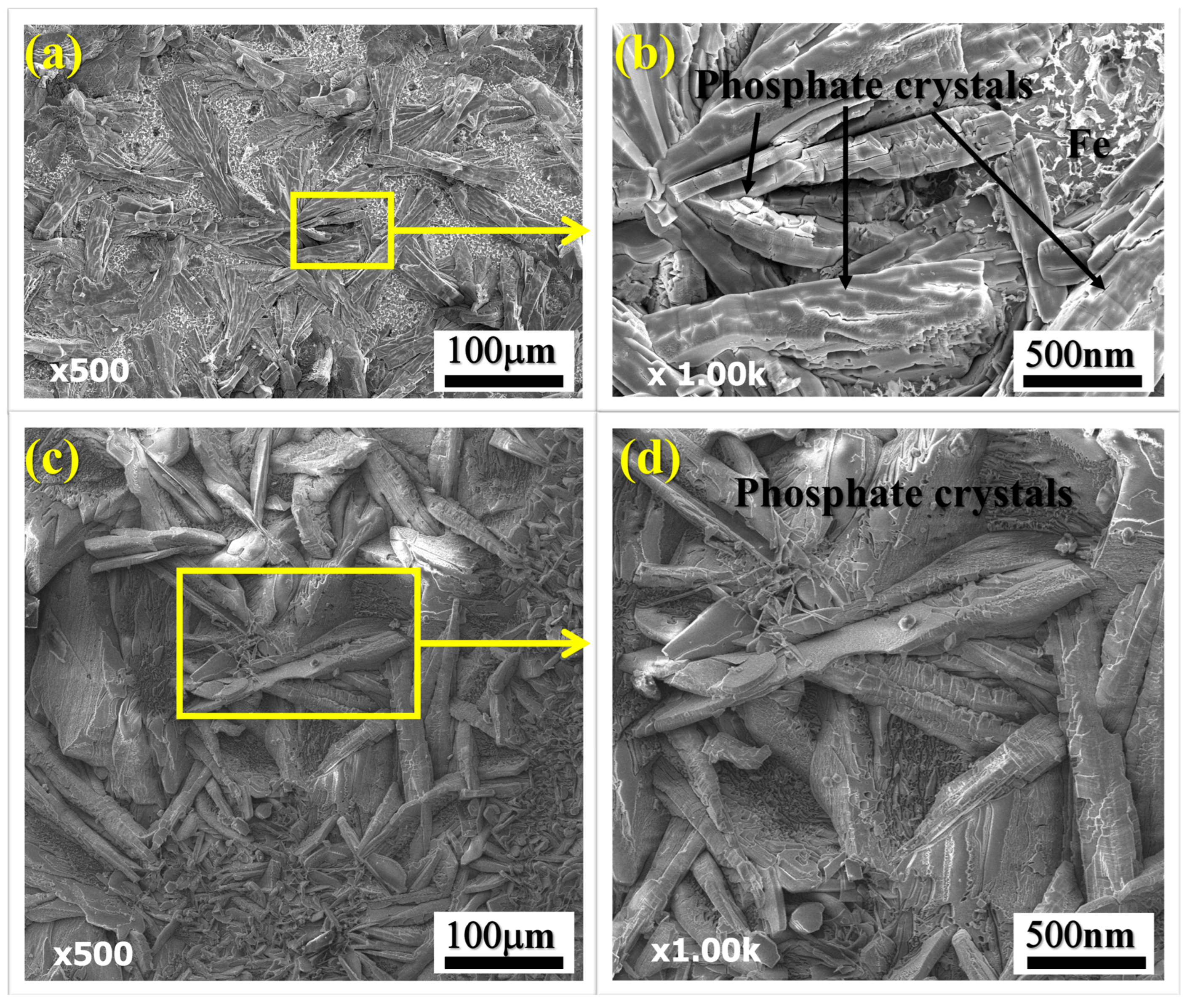
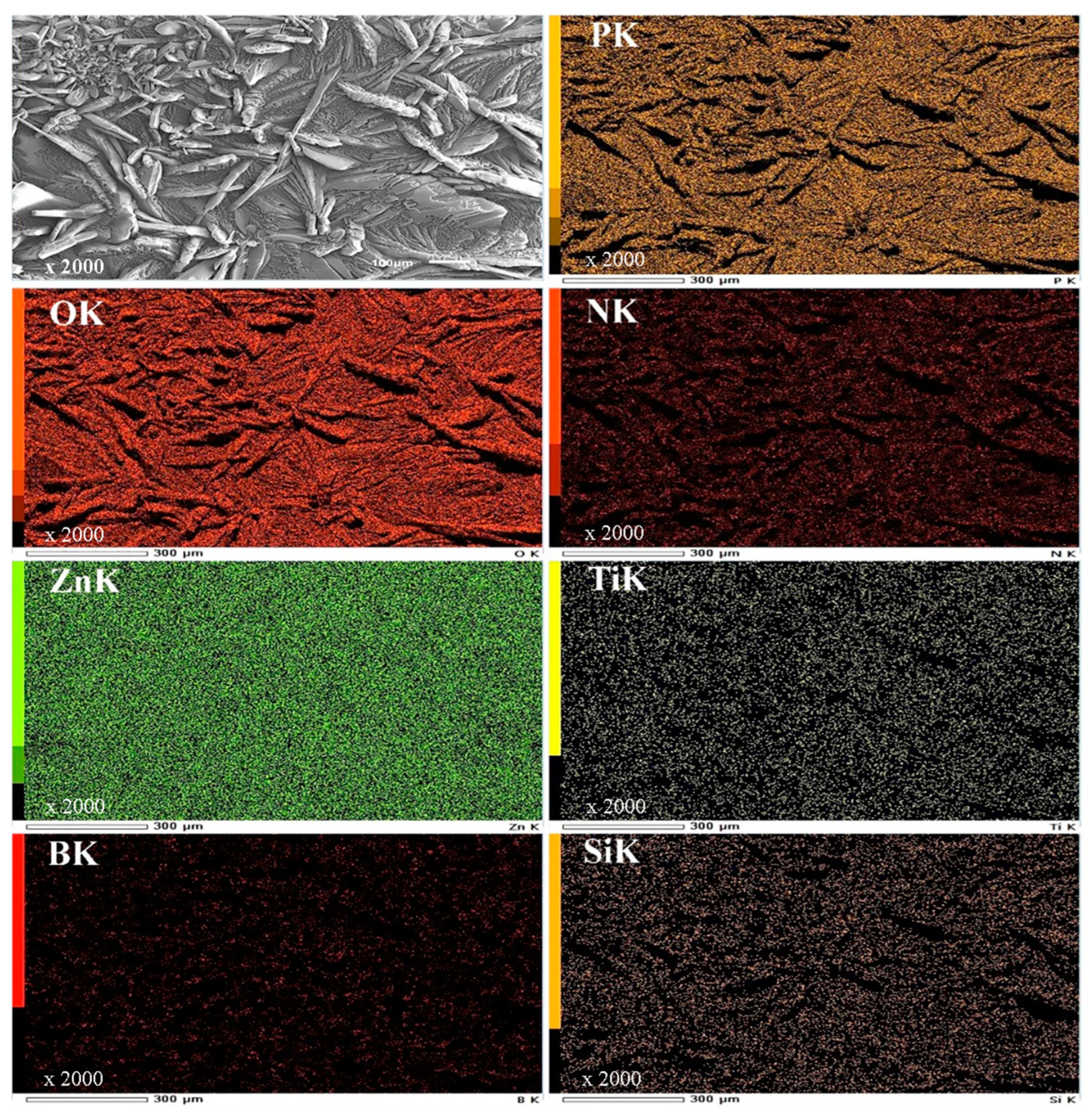
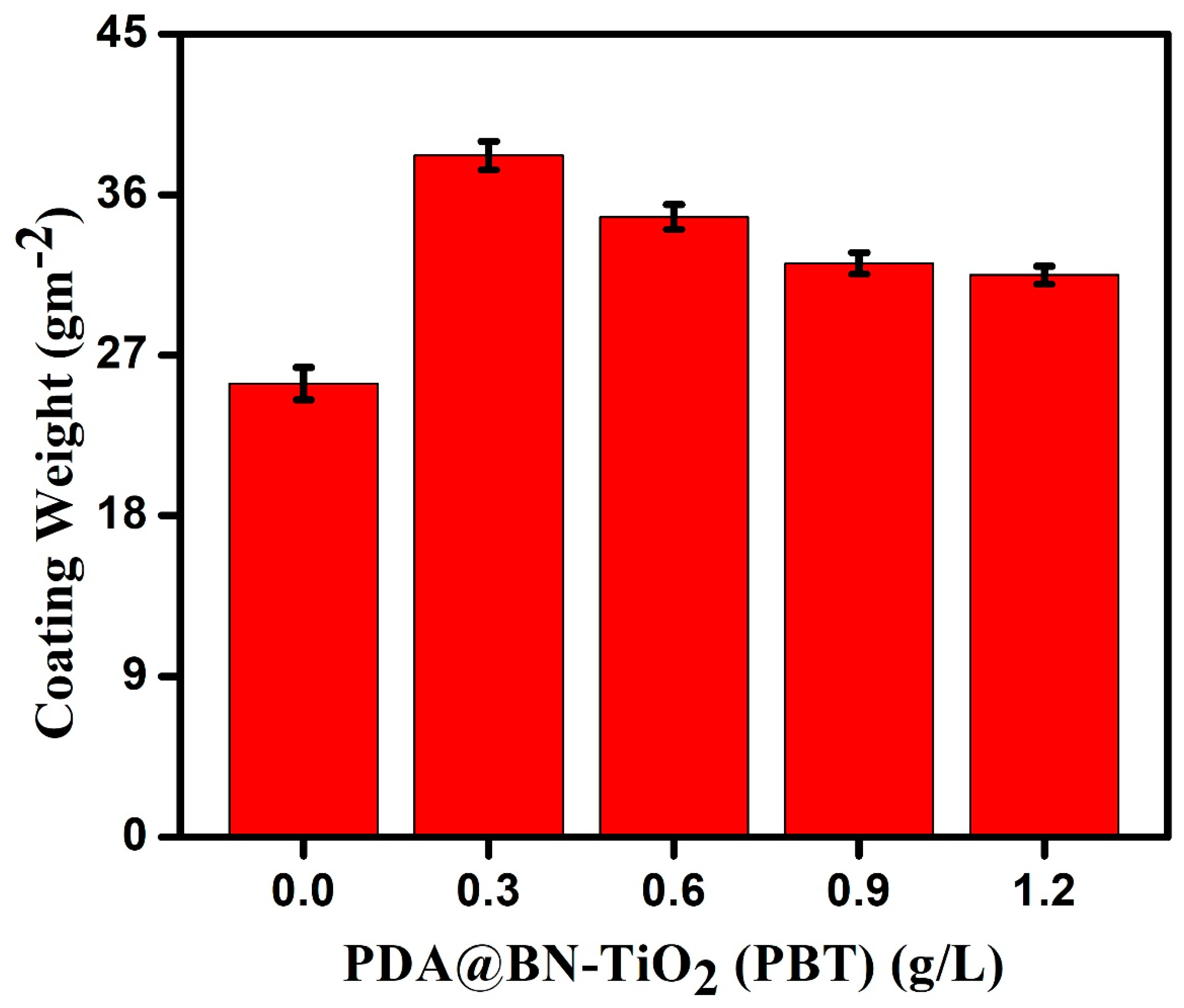
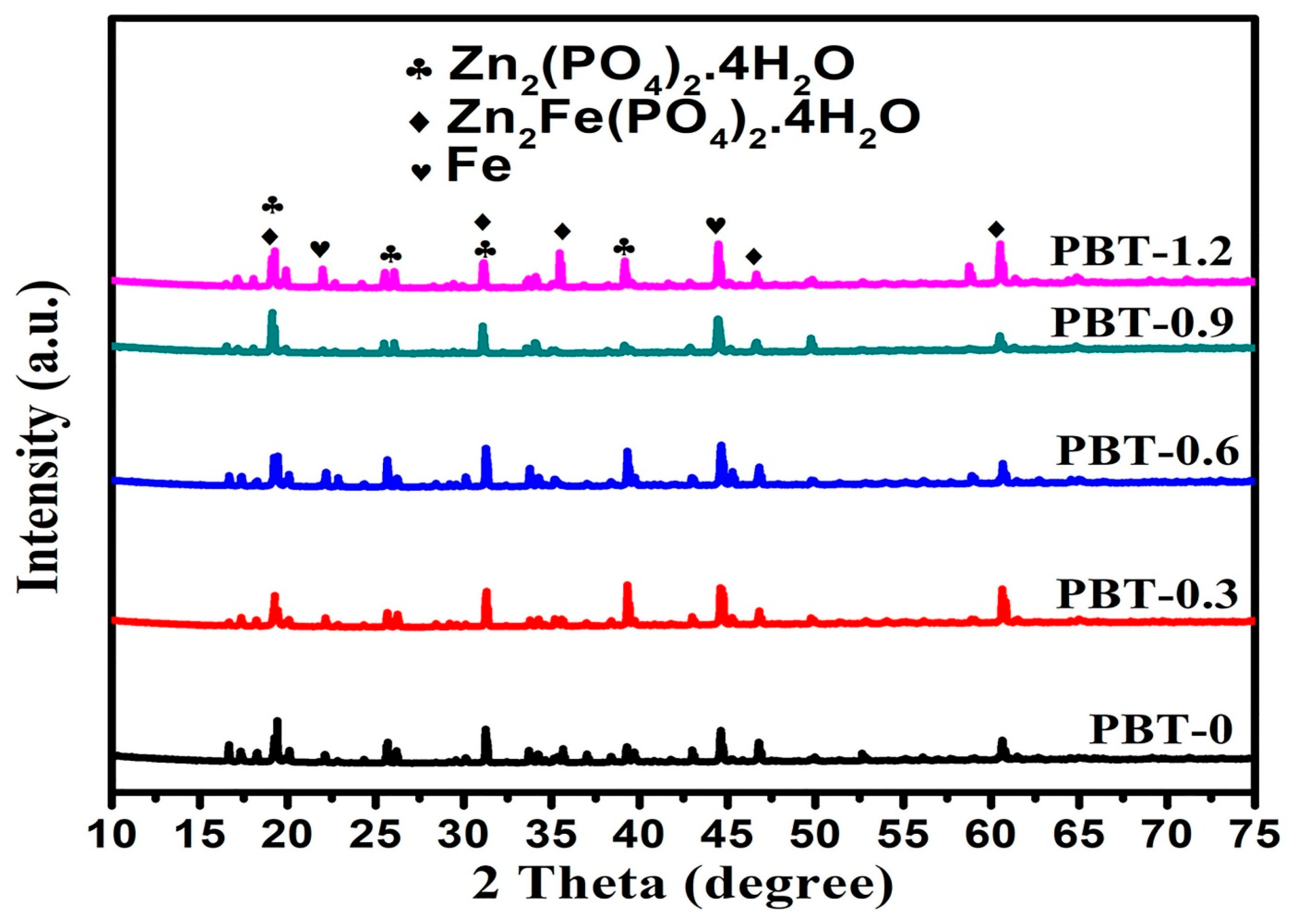
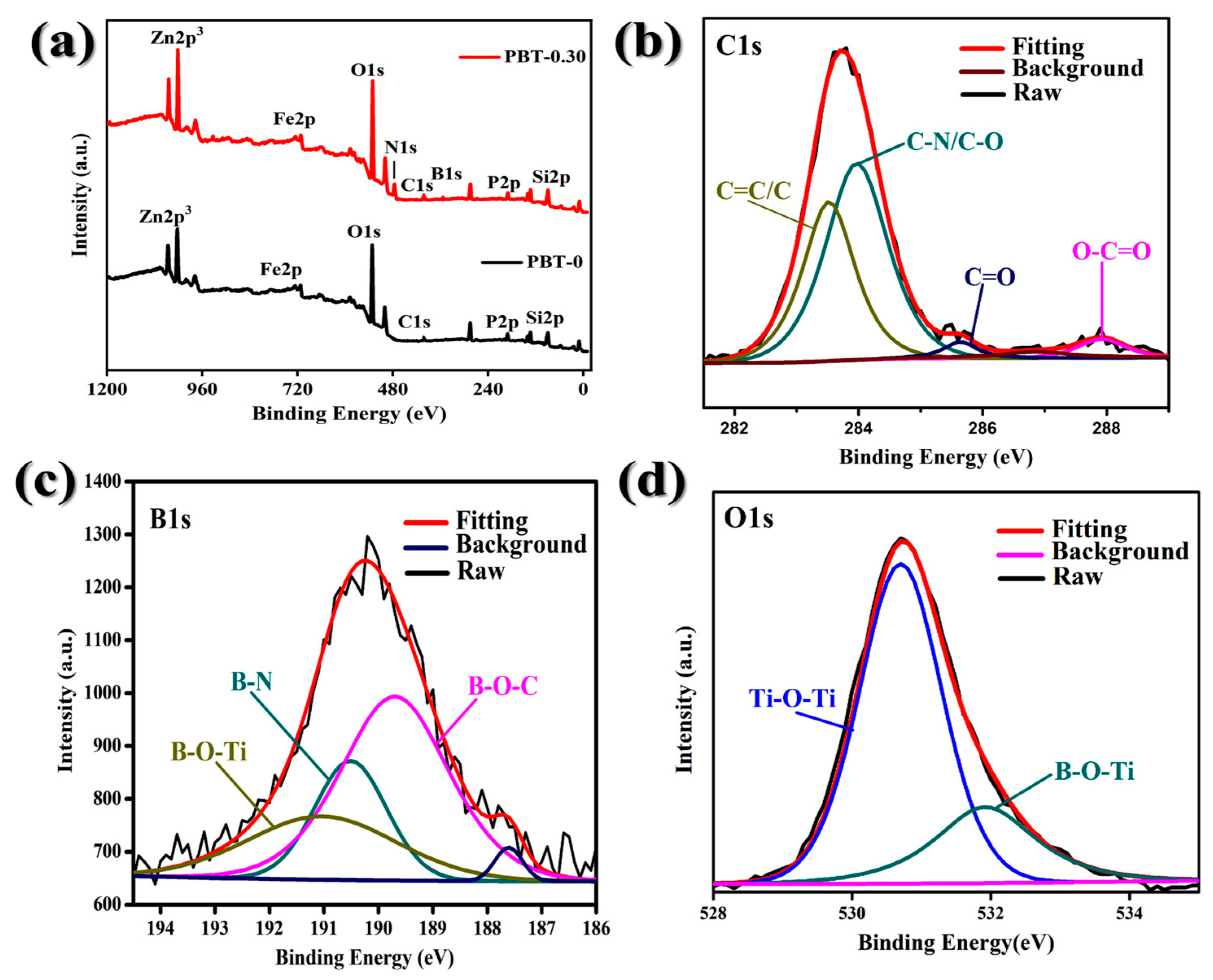
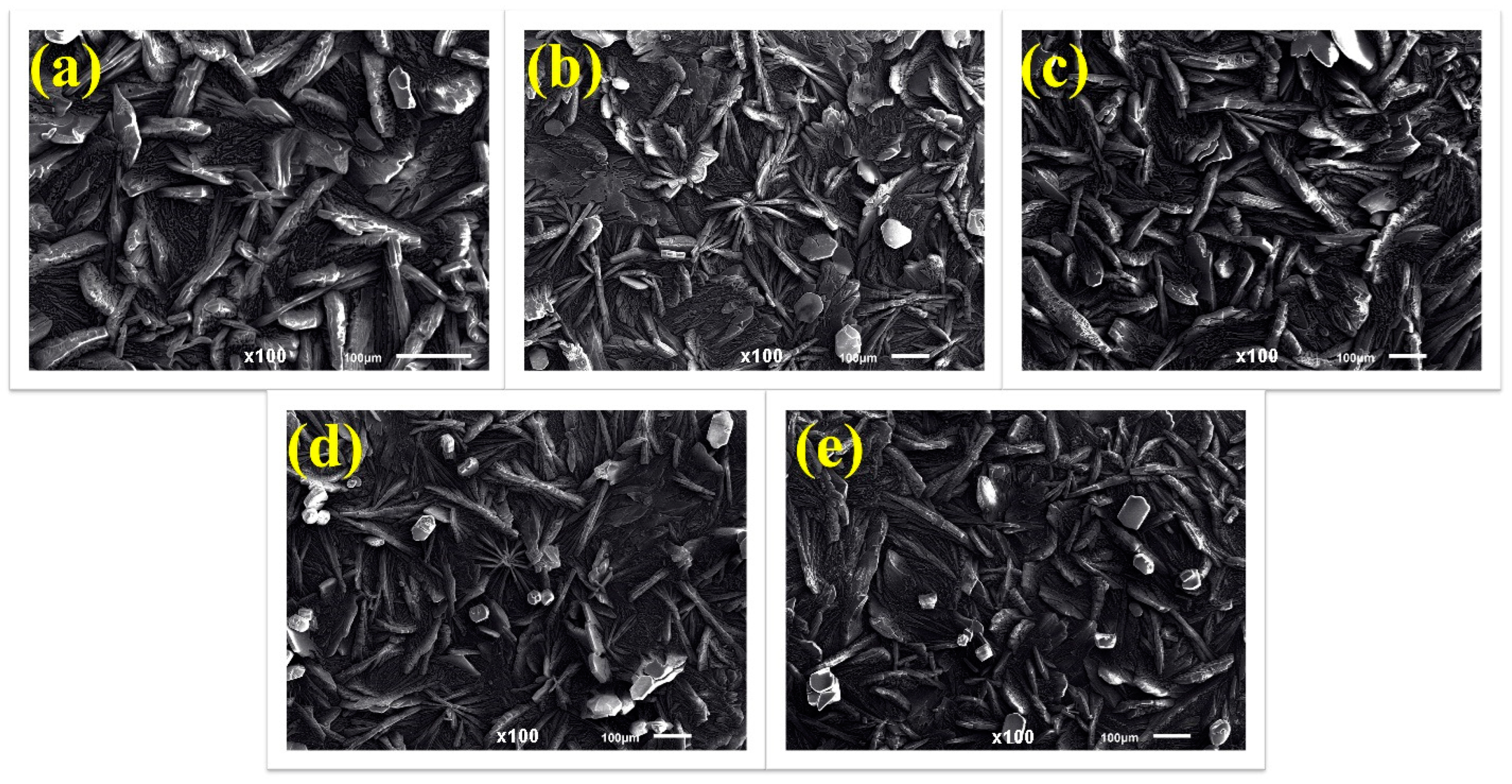
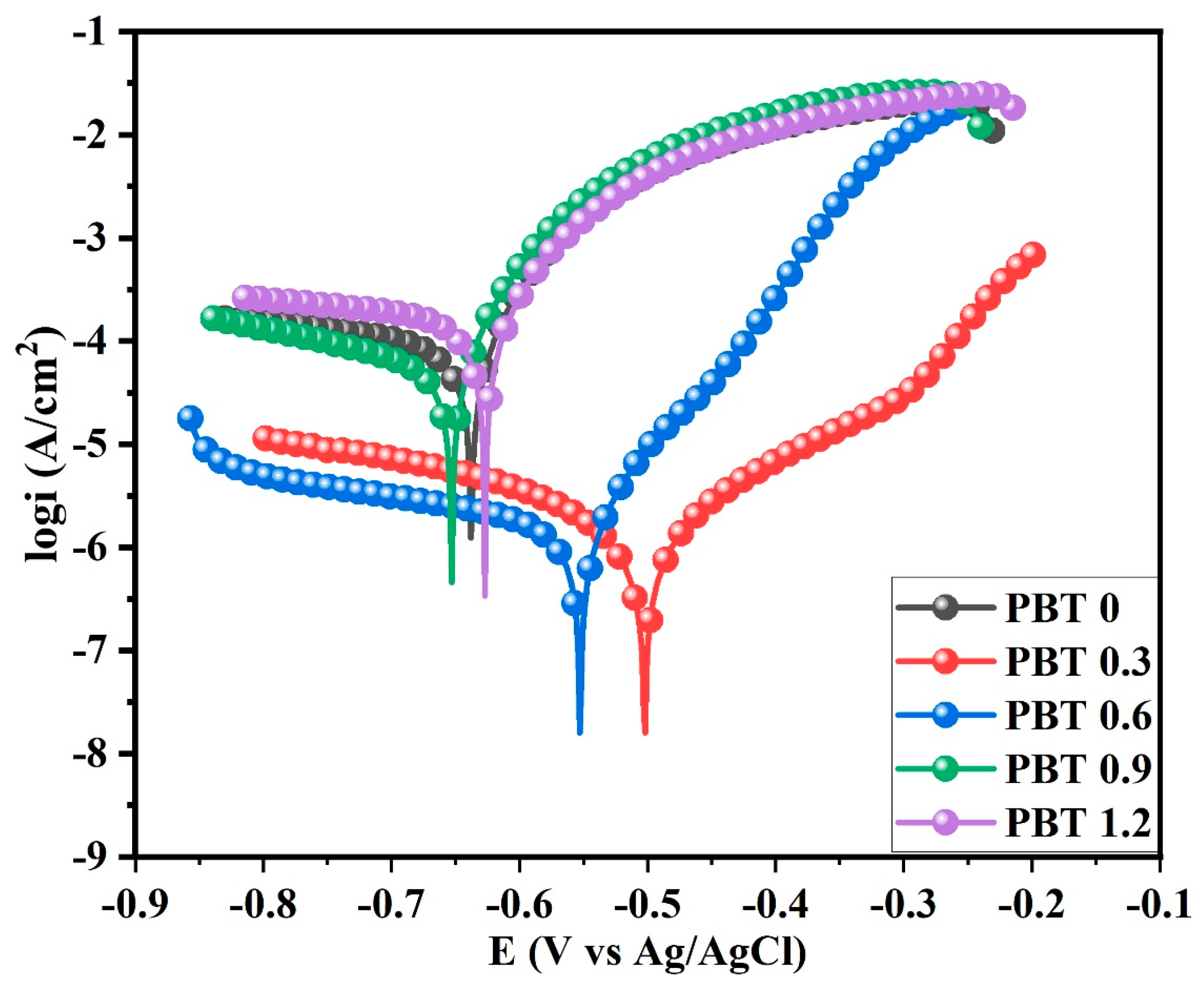
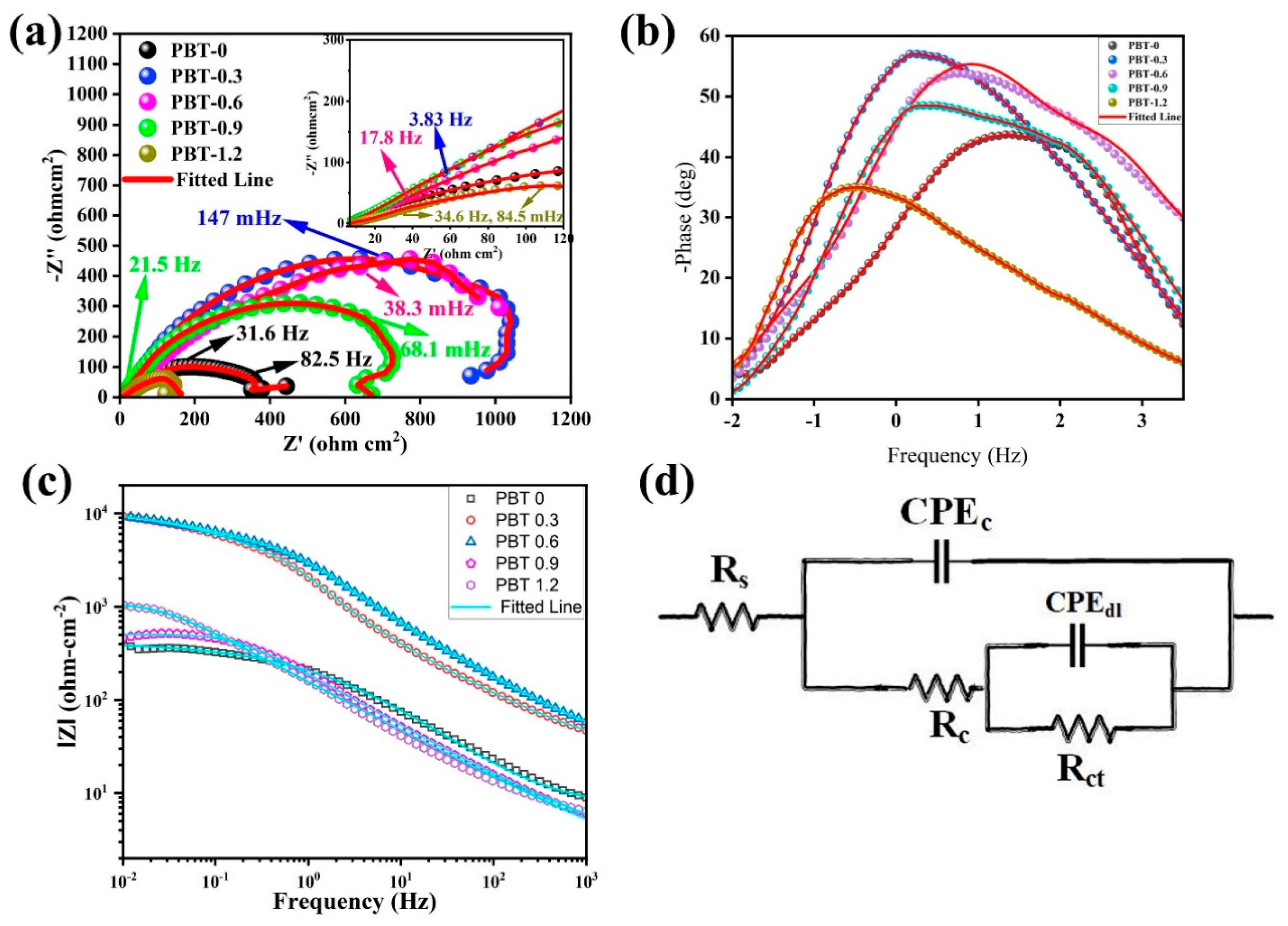

| Element | C | S | Si | P | Mn | Fe |
|---|---|---|---|---|---|---|
| wt% | 0.22 | 0.05 | 0.35 | 0.05 | 1.40 | Bal. |
| Formulations | Concentration | Operating Conditions |
|---|---|---|
| H3PO4 (85%) | 3.0 g/L | Temperature (T): 40 °C |
| KH560 (Silane) | 1.50 g/L | Period: 30 min |
| H3PO3 (99%) | 2.0 g/L | |
| Zn(H2PO4)2·2H2O | 50 g/L | |
| Zn(NO3)2·6H2O | 80 g/L | |
| PDA@h-BN-TiO2 | 0.3–1.2 g/L |
| Sample Code | ECorr (V) | iCorr (A/cm2) | Corrosion Rate (mm/Year) | Rp | η% |
|---|---|---|---|---|---|
| PBT-0 | −0.531 | 1.43 × 10−4 | 2.87 × 101 | 287 | - |
| PBT-0.3 | −0.498 | 1.63 × 10−6 | 7.46 × 101 | 2387 | 98% |
| PBT-0.6 | −0.557 | 1.85 × 10−6 | 8.47 × 101 | 2088 | 97% |
| PBT-0.9 | −0.540 | 6.21 × 10−5 | 2.85 × 101 | 1367 | 56% |
| PBT-1.2 | −0.561 | 1.65 × 10−4 | 4.07 × 101 | 985 | 15% |
| Sample | Rs | CPEc | n | Rc | CPEdl | n | Rct |
|---|---|---|---|---|---|---|---|
| PBT-0 | 6.47 | 2.42 × 10−4 | 0.55 | 22.90 | 9.5 × 10−4 | 0.52 | 378 |
| PBT-0.3 | 5.74 | 1.77 × 10−5 | 0.65 | 35.56 | 7.19 × 10−5 | 0.62 | 935 |
| PBT-0.6 | 5.34 | 2.41 × 10−5 | 0.62 | 34.48 | 5.07 × 10−5 | 0.60 | 825 |
| MBN-0.9 | 3.71 | 7.57 × 10−4 | 0.58 | 28.72 | 4.67 × 10−4 | 0.61 | 489 |
| PBT-1.2 | 4.42 | 3.30 × 10−4 | 0.54 | 24.53 | 3.56 × 10−4 | 0.52 | 359.5 |
Disclaimer/Publisher’s Note: The statements, opinions and data contained in all publications are solely those of the individual author(s) and contributor(s) and not of MDPI and/or the editor(s). MDPI and/or the editor(s) disclaim responsibility for any injury to people or property resulting from any ideas, methods, instructions or products referred to in the content. |
© 2023 by the authors. Licensee MDPI, Basel, Switzerland. This article is an open access article distributed under the terms and conditions of the Creative Commons Attribution (CC BY) license (https://creativecommons.org/licenses/by/4.0/).
Share and Cite
Muhammad, M.; Ma, R.; Du, A.; Fan, Y.; Zhao, X.; Cao, X. Preparation and Modification of Polydopamine Boron Nitride—Titanium Dioxide Nanohybrid Particles Incorporated into Zinc Phosphating Bath to Enhance Corrosion Performance of Zinc Phosphate-Silane Coated Q235 Steel. Materials 2023, 16, 3835. https://doi.org/10.3390/ma16103835
Muhammad M, Ma R, Du A, Fan Y, Zhao X, Cao X. Preparation and Modification of Polydopamine Boron Nitride—Titanium Dioxide Nanohybrid Particles Incorporated into Zinc Phosphating Bath to Enhance Corrosion Performance of Zinc Phosphate-Silane Coated Q235 Steel. Materials. 2023; 16(10):3835. https://doi.org/10.3390/ma16103835
Chicago/Turabian StyleMuhammad, Mustafa, Ruina Ma, An Du, Yongzhe Fan, Xue Zhao, and Xiaoming Cao. 2023. "Preparation and Modification of Polydopamine Boron Nitride—Titanium Dioxide Nanohybrid Particles Incorporated into Zinc Phosphating Bath to Enhance Corrosion Performance of Zinc Phosphate-Silane Coated Q235 Steel" Materials 16, no. 10: 3835. https://doi.org/10.3390/ma16103835





